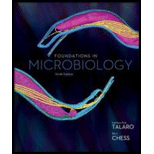
a. Explain the relationship between herd immunity and the development of influenzal pandemics.
b. Why will herd immunity be lacking if antigenic shift or drift occurs?
To analyze:
- The relationship between herd immunity and the development of influenzal pandemics.
- Why herd immunity would be lacking if antigenic shift or drift occurs
Introduction:
Viruses may come in more than one strain, varying in their surface antigens. Herd immunity refers to the general resistance of a population to a particular strain of a virus.
Explanation of Solution
- When herd immunity for a strain of the influenza virus is high, it means that most individuals in the population won’t be affected by that strain. Consequently, the strain is less likely to spread in the population. This also means that there are fewer instances when the strain reaches other populations during travel, especially if the other population also has high immunity. When herd immunity against a strain is lacking, the strain will circulate in the population, and there will be many more chances of exposure to other populations due to travel or migration. This is what leads to influenza pandemics.
- Herd immunity is a result of the immune systems of the individuals in a population having the ability to recognize an antigen on the surface of the virus. When the immune system cannot immediately recognize the antigen, it cannot react fast enough to prevent infection. During antigenic drift and shift, the composition of the antigenic proteins change as a result of mutation or gene exchange. Therefore, during such events new strains of the virus are created, and herd immunity for these new strains will be lacking.
Low herd immunity increases the chances for influenza pandemics to occur. When antigenic drift or shift occur, there are changes in the surface antigens of the virus. This means that the immune systems of the individuals in the population cannot immediately recognize the new strains of virus that have formed. Therefore, her immunity is lacking during such events.
Want to see more full solutions like this?
Chapter 25 Solutions
Foundations in Microbiology
- For which disease active and passive immunization (antibodies) is given simultaneously? Explain how effective this strategy would be and whyarrow_forwardDescribe the factors determining host resistance.arrow_forwardDescribe the specific components of acquired immunity that wouldbe necessary to control rabies virus.arrow_forward
- Briefly explain the behaviors most likely to spread HIV.arrow_forwardExplain why frequent handwashing may reduce thetransmission of influenza.arrow_forwardDiscuss host responses to infectious disease agents. Be sure to include herd immunity as a community health concept. Cite referencesarrow_forward
- Explain the reasons for changes in antibody titer for a singleinfectious agent, from the acute phase through the convalescentphase of the infection.arrow_forwardIn short Explain why secondary bacterial infection is common in persons with influenza Asap.arrow_forwardExplain why a different influenza vaccine is necessary every year. How is this different from the development of pandemic versions? Please include in your answer the terms antigenic shift and antigenic drift.arrow_forward
- Consider that the Herd Immunity Threshold is dependent on the reproduction number for an infectious disease. The combination of herd immunity and quarantines were highly effective for eradicating smallpox. What is different about the symptoms of polio infection that makes quarantining infected individuals much more difficult?arrow_forwardWhen can we say that HIV has progressed to the stage of AIDS? List several signs and explain why they occurarrow_forwardShortly discuss the different immunodeficiency and immunoproliferative disorders and include the following: a. General Characteristic b. Cause c. Signs and Symptoms d. Clinical Diagnosis and Clinical Picture e. Immunologic Manifestations f. Treatment.arrow_forward
 Human Anatomy & Physiology (11th Edition)BiologyISBN:9780134580999Author:Elaine N. Marieb, Katja N. HoehnPublisher:PEARSON
Human Anatomy & Physiology (11th Edition)BiologyISBN:9780134580999Author:Elaine N. Marieb, Katja N. HoehnPublisher:PEARSON Biology 2eBiologyISBN:9781947172517Author:Matthew Douglas, Jung Choi, Mary Ann ClarkPublisher:OpenStax
Biology 2eBiologyISBN:9781947172517Author:Matthew Douglas, Jung Choi, Mary Ann ClarkPublisher:OpenStax Anatomy & PhysiologyBiologyISBN:9781259398629Author:McKinley, Michael P., O'loughlin, Valerie Dean, Bidle, Theresa StouterPublisher:Mcgraw Hill Education,
Anatomy & PhysiologyBiologyISBN:9781259398629Author:McKinley, Michael P., O'loughlin, Valerie Dean, Bidle, Theresa StouterPublisher:Mcgraw Hill Education, Molecular Biology of the Cell (Sixth Edition)BiologyISBN:9780815344322Author:Bruce Alberts, Alexander D. Johnson, Julian Lewis, David Morgan, Martin Raff, Keith Roberts, Peter WalterPublisher:W. W. Norton & Company
Molecular Biology of the Cell (Sixth Edition)BiologyISBN:9780815344322Author:Bruce Alberts, Alexander D. Johnson, Julian Lewis, David Morgan, Martin Raff, Keith Roberts, Peter WalterPublisher:W. W. Norton & Company Laboratory Manual For Human Anatomy & PhysiologyBiologyISBN:9781260159363Author:Martin, Terry R., Prentice-craver, CynthiaPublisher:McGraw-Hill Publishing Co.
Laboratory Manual For Human Anatomy & PhysiologyBiologyISBN:9781260159363Author:Martin, Terry R., Prentice-craver, CynthiaPublisher:McGraw-Hill Publishing Co. Inquiry Into Life (16th Edition)BiologyISBN:9781260231700Author:Sylvia S. Mader, Michael WindelspechtPublisher:McGraw Hill Education
Inquiry Into Life (16th Edition)BiologyISBN:9781260231700Author:Sylvia S. Mader, Michael WindelspechtPublisher:McGraw Hill Education





